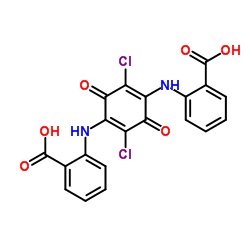ec 2.7.3.2

ec 2.7.3.2 structure
|
Common Name | ec 2.7.3.2 | ||
|---|---|---|---|---|
| CAS Number | 9001-15-4 | Molecular Weight | 447.225 | |
| Density | 1.7±0.1 g/cm3 | Boiling Point | 629.9±55.0 °C at 760 mmHg | |
| Molecular Formula | C20H12Cl2N2O6 | Melting Point | N/A | |
| MSDS | USA | Flash Point | 334.8±31.5 °C | |
|
Initial characterization of the human central proteome.
BMC Syst. Biol. 5 , 17, (2011) On the basis of large proteomics datasets measured from seven human cell lines we consider their intersection as an approximation of the human central proteome, which is the set of proteins ubiquitously expressed in all human cells. Composition and properties... |
|
|
The DNA sequence and biology of human chromosome 19.
Nature 428(6982) , 529-35, (2004) Chromosome 19 has the highest gene density of all human chromosomes, more than double the genome-wide average. The large clustered gene families, corresponding high G + C content, CpG islands and density of repetitive DNA indicate a chromosome rich in biologi... |
|
|
A quantitative atlas of mitotic phosphorylation.
Proc. Natl. Acad. Sci. U. S. A. 105(31) , 10762-7, (2008) The eukaryotic cell division cycle is characterized by a sequence of orderly and highly regulated events resulting in the duplication and separation of all cellular material into two newly formed daughter cells. Protein phosphorylation by cyclin-dependent kin... |
|
|
Complete sequencing and characterization of 21,243 full-length human cDNAs.
Nat. Genet. 36 , 40-5, (2004) As a base for human transcriptome and functional genomics, we created the "full-length long Japan" (FLJ) collection of sequenced human cDNAs. We determined the entire sequence of 21,243 selected clones and found that 14,490 cDNAs (10,897 clusters) were unique... |
|
|
The status, quality, and expansion of the NIH full-length cDNA project: the Mammalian Gene Collection (MGC).
Genome Res. 14 , 2121-7, (2004) The National Institutes of Health's Mammalian Gene Collection (MGC) project was designed to generate and sequence a publicly accessible cDNA resource containing a complete open reading frame (ORF) for every human and mouse gene. The project initially used a r... |
|
|
Quantitative phosphoproteomics reveals widespread full phosphorylation site occupancy during mitosis.
Sci. Signal. 3(104) , ra3, (2010) Eukaryotic cells replicate by a complex series of evolutionarily conserved events that are tightly regulated at defined stages of the cell division cycle. Progression through this cycle involves a large number of dedicated protein complexes and signaling path... |
|
|
Pretreatment with hydrogen-rich saline reduces the damage caused by glycerol-induced rhabdomyolysis and acute kidney injury in rats
J. Surg. Res. 188(1) , 243-9, (2014) Background Rhabdomyolysis is a leading cause of acute kidney injury. The pathophysiological process involves oxidative stress and inflammation. Hydrogen-rich saline (HRS) is an antioxidant and anti-inflammatory. This study explored the protective effect of pr... |
|
|
50 Years ago in The Journal of Pediatrics: the hypotonic infant.
J. Pediatr. 164(3) , 565, (2014)
|
|
|
[Influence of ionizing radiation on enzymatic activity and state of nucleus-nucleolar apparatus in rat hepatocytes].
Radiats. Biol. Radioecol. 53(1) , 55-62, (2013) The effects of a single exposure of rats to the whole-body roentgen irradiation at the doses of 3.5 Gy and 4.5 Gy on the activity of creatine kinase, purine nucleoside phosphorylase, alanine aminotransferase, aspartate aminotransferase, as well as on the stat... |
|
|
Disturbance of redox homeostasis by ornithine and homocitrulline in rat cerebellum: a possible mechanism of cerebellar dysfunction in HHH syndrome.
Life Sci. 93(4) , 161-8, (2013) Cerebellar ataxia is commonly observed in hyperornithinemia-hyperammonemia-homocitrullinuria (HHH) syndrome, an inherited metabolic disorder biochemically characterized by ornithine (Orn), homocitrulline (Hcit) and ammonia accumulation. Since the pathophysiol... |